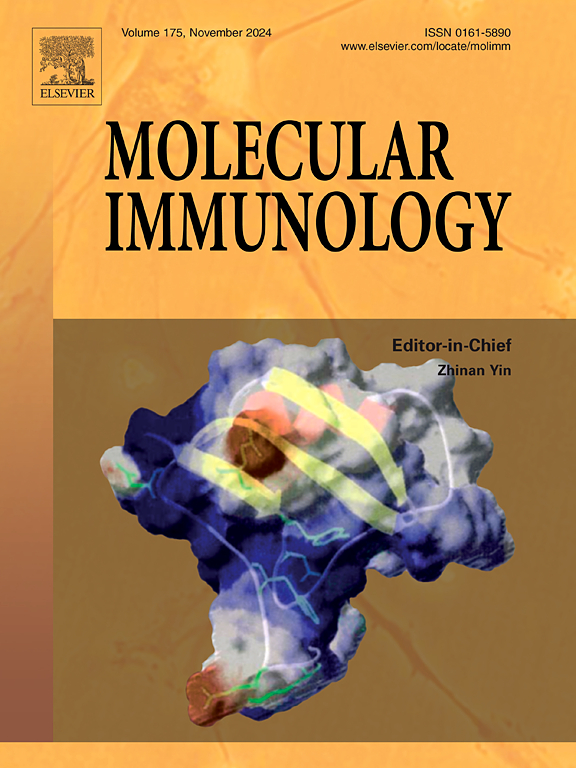幽门螺杆菌延缓中性粒细胞凋亡,但也驱动具有渗漏质膜的细胞的形成:对炎症的影响
IF 3
3区 医学
Q2 BIOCHEMISTRY & MOLECULAR BIOLOGY
引用次数: 0
摘要
在湄公河流域下游国家,猪腹蛇(Opisthorchis viverrini, OV)诱导的胆管癌(CCA)是一个重要的公共卫生问题。OV是幽门螺杆菌(h.p ylori)的储存库,因此许多人同时感染了这两种生物致癌物。本研究旨在探讨具有或缺乏致病性因子CagA (CagA +和CagA -)的幽门螺杆菌等基因菌株与中性粒细胞的相互作用。两株幽门螺杆菌均与中性粒细胞体外共培养,检测中性粒细胞活化、吞噬、活性氧(ROS)产生和细胞存活/凋亡。这两种等基因菌株都刺激了吞噬作用,而cagA菌株诱导的ROS产量略高,这两种菌株都是中性粒细胞的有效激活剂。值得注意的是,幽门螺杆菌在共孵育30 min后诱导中性粒细胞亚群快速细胞死亡,同时延长了在最初细胞死亡中存活下来的中性粒细胞的寿命。这种初始孵育导致碘化丙啶(PI)+ 中性粒细胞的出现,即质膜受损的细胞可能导致释放促炎中性粒细胞内容物。虽然在幽门螺杆菌孵育24 h(和48 h)后检测到更多的活中性粒细胞,但那些没有存活的细胞也表现出质膜受损的特征(即PI+)。我们认为,与幽门螺杆菌孵育后,具有渗漏质膜的PI+ 中性粒细胞和具有增强存活率的非凋亡中性粒细胞联合使用可能会导致持续性炎症。这些发现为OV和幽门螺杆菌合并感染的免疫发病机制提供了新的见解,可能有助于改善OV的治疗策略。本文章由计算机程序翻译,如有差异,请以英文原文为准。
Helicobacter pylori delays neutrophil apoptosis but also drives the formation of cells with a leaky plasma membrane: Implications for inflammation
Opisthorchis viverrini (OV)-induced cholangiocarcinoma (CCA) is a significant public health concern in countries in the Lower Mekong Basin. OV is a reservoir for Helicobacter pylori (H. pylori), and so many individuals are co-infected with these two biological carcinogens. Our study aimed to investigate interactions between H. pylori isogenic strains possessing or lacking the pathogenicity factor CagA (cagA+ and cagA-) with neutrophils. Both H. pylori strains were co-cultured with neutrophils in vitro, and neutrophil activation, phagocytosis, reactive oxygen species (ROS) production, and cell survival/apoptosis were measured. Both isogenic strains of H. pylori stimulated phagocytosis and while the cagA- strain induced slightly higher ROS production, both strains served as potent activators of neutrophils. Notably, H. pylori induced rapid cell death in a sub-population of neutrophils after 30 min of co-incubation while extending the lifespan of the neutrophils that survived this initial cell death. This initial incubation resulted in the appearance of propidium iodide (PI)+ neutrophils, i.e. cells with a compromised plasma membrane that could result in the release of inflammation-promoting neutrophil contents. While significantly more viable neutrophils were detected after 24 h (and 48 h) incubation with H. pylori, those cells that did not survive also showed characteristics of a compromised plasma membrane (i.e. PI+). We propose that the combinations of PI+ neutrophils with leaky plasma membranes and non-apoptotic neutrophils with enhanced survival after incubation with H. pylori may drive persistent inflammation. These findings offer new insights into the immunopathogenesis of OV and H. pylori co-infections, which may help improve OV treatment strategies.
求助全文
通过发布文献求助,成功后即可免费获取论文全文。
去求助
来源期刊

Molecular immunology
医学-免疫学
CiteScore
6.90
自引率
2.80%
发文量
324
审稿时长
50 days
期刊介绍:
Molecular Immunology publishes original articles, reviews and commentaries on all areas of immunology, with a particular focus on description of cellular, biochemical or genetic mechanisms underlying immunological phenomena. Studies on all model organisms, from invertebrates to humans, are suitable. Examples include, but are not restricted to:
Infection, autoimmunity, transplantation, immunodeficiencies, inflammation and tumor immunology
Mechanisms of induction, regulation and termination of innate and adaptive immunity
Intercellular communication, cooperation and regulation
Intracellular mechanisms of immunity (endocytosis, protein trafficking, pathogen recognition, antigen presentation, etc)
Mechanisms of action of the cells and molecules of the immune system
Structural analysis
Development of the immune system
Comparative immunology and evolution of the immune system
"Omics" studies and bioinformatics
Vaccines, biotechnology and therapeutic manipulation of the immune system (therapeutic antibodies, cytokines, cellular therapies, etc)
Technical developments.
 求助内容:
求助内容: 应助结果提醒方式:
应助结果提醒方式:


